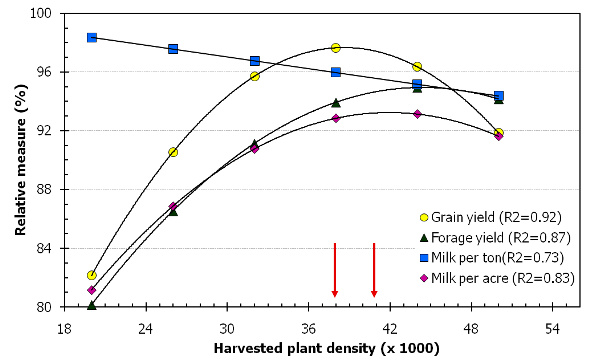April 9, 2009
Field Crops 28.424 - 62
Corn plant density for maximum grain and silage production
Joe Lauer, Corn Agronomist
The plant density that maximizes corn grain and silage yield has been increasing
through time. The economic optimum plant density is a function of corn
yield and quality responses, seed cost, and grain or silage price. The economic plant density is lower than the plant density that maximizes
yield.
Plots were established at the UW-ARS at Arlington from 2000 to 2008.
These plots were 8 rows wide by 25 feet long. Four rows were harvested
for silage and the remaining 4 rows were harvested later for grain. The
target plant densities varied by year and ranged from 14 000 to 56 000
plants/A. Adapted, high-performing hybrids were selected using results
from the UW Corn Trials and varied for relative maturity (full- and
shorter-season). Milk per Ton and Milk per Acre were estimated using
Milk2006. The treatment (hybrid x plant density) mean that maximized the
measure within a year was set to 100%. The results in Figure 1 were
summarized across all hybrids and the relationship between various
measures and plant density was estimated using regression models at 20
000, 26 000, 32 000, 38 000, 44 000, and 50 000 plants per acre.
Maximum grain yield was measured at 38 000 plants/A. The relationship
increased to a maximum and then decreased as plant density changed. In
agronomic research, it is very difficult to measure grain yield
differences less that 5%. So, grain yields within 5% of the maximum
grain yield were measured at plant density above 28 000 plants/A.
Maximum forage yield was measured at 44 000 plants/A and was within 5%
of the maximum when plant densities were above 30 000 plants/A. Forage
quality as measured by Milk per Ton decreased linearly from a maximum at
20 000 plants/A, but was within 5% of the maximum across the range of
plant densities measured. Maximum Milk per Acre was measured at 41 000
plants/A and was within 5% of the maximum at 28 000 plants/A. These
results are a good example of the trade-off that exists between forage
yield and quality, i.e. the plant density that maximizes Milk per Acre
is intermediate between plant densities that maximize forage yield and Milk per Ton.
Plant densities that maximize grain and forage yield are higher than
currently recommended plant densities. These results indicate that the
plant density that maximizes forage production is about 3000 plants/A
higher than the plant density for maximizing grain yield. The economic
optimum plant density is lower than the plant density required to
maximize grain or forage yield. The economic optimum plant density is
likely different between farms and fields within farms.
Adjusting plant density is probably one of the best ways to move off
current yield levels. Begin by planting a field to what you think is the
optimum plant density and at two or three places (rounds) in the field,
increase your population by 10%. For example, if you currently plant at
30 000 plants/A, do so for the majority of your field, but in two or
three rounds increase the population to 33 000 plants/A. Measure yield
at the end of the season and during the season watch for "runt" plants,
tillering, prolific versus ear bareness on plants, big versus small
ears, ear tip "nose-back" and plant lodging. Adjust the field
accordingly the following year.

Figure 1. The relationship between plant density and grain yield, forage
yield, Milk per Ton and Milk per Acre during 2000-2008 (n= 447 plots) at
Arlington, WI.